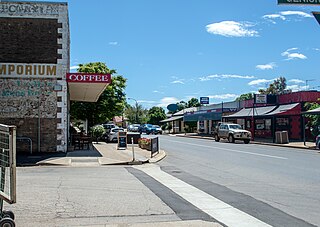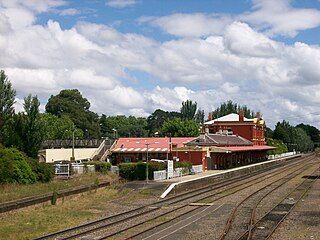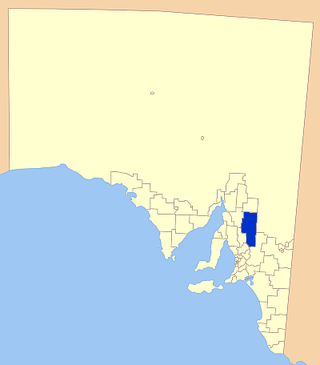
Adelaide railway station is the central terminus of the Adelaide Metro railway system. All lines approach the station from the west, and it is a terminal station with no through lines, with most of the traffic on the metropolitan network either departing or terminating here. It has nine below-ground platforms, all using broad gauge track. The station is located on the north side of North Terrace, west of Parliament House.

Peterborough is a town in the mid north of South Australia, in wheat country, just off the Barrier Highway. It was originally named Petersburg after the landowner, Peter Doecke, who sold land to create the town. It was one of 69 places in South Australia renamed in 1917 due to anti-German sentiments during World War I.

Rail transport in the Australian state of South Australia is provided by a number of railway operators who operate over the government-owned railway lines. The network consists of 1435 mm standard gauge links to other states, the 1600 mm broad gauge suburban railways in Adelaide, a freight-only branch from Dry Creek to Port Adelaide and Pelican Point, a narrow-gauge gypsum haulage line on the Eyre Peninsula, and both copper–gold concentrate and coal on the standard-gauge line in the Adelaide–Darwin rail corridor north of Tarcoola.

Riverton is a small town in the Mid North of South Australia, in the Gilbert Valley. It is situated on the Gilbert River, from which the town derives its name. Both the Gilbert Valley and Gilbert River were named after the South Australian pioneer Thomas Gilbert. Riverton was first settled in 1856, as a settlement along the bullock track from the mining town of Burra to the capital city Adelaide. It grew from a plan designed by a James Masters who had established the nearby town of Saddleworth. The streets of Riverton received their names chiefly from James Masters and his friends. They commemorate persons notable in the history of the district or the state. At the 2011 census, Riverton had a population of 810. Including the rural areas surrounding the town, the population was 1213.

Moss Vale railway station is a heritage-listed railway station on the Main Southern line in New South Wales, Australia. It serves the town of Moss Vale, opening on 2 December 1867. It was added to the New South Wales State Heritage Register on 2 April 1999.

Seymour railway station is on the Tocumwal and North East lines in Victoria, Australia. It serves the town of the same name, and opened on 20 November 1872. The station is the terminus for V/Line Seymour line services. V/Line services to Shepparton and Albury, and New South Wales XPT services to Sydney, also stop at the station.

The Regional Council of Goyder is a local government area located in the Mid North region of South Australia. The council area is reliant on agriculture as a mainstay of its economy, with manufacturing and tourism also becoming prominent. The council seat is at Burra. A branch office is at Eudunda.
Hallett is a small town in Mid North region of South Australia, situated on the Barrier Highway 32 kilometres (20 mi) north of Burra and 38 kilometres (24 mi) south-east of Jamestown, Hallett lies close to Goyder's Line, plotted in the nineteenth century by George Goyder, separating the land suitable for cropping from the land suitable for grazing.

Manoora is a settlement in the Mid North region of South Australia on the Barrier Highway and upper reaches of the Gilbert River. At the 2006 census, Manoora had a population of 277.

The Roseworthy–Peterborough railway line is a closed railway line in South Australia. It was first opened from a junction at Roseworthy on the Morgan railway line through Hamley Bridge, Riverton, initially to Tarlee, then extended in stages to Peterborough. The line was closed in sections in the 1980s with the final section from Gawler to Roseworthy being used in 2007.
The District Council of Hallett was a local government area in South Australia from 1877 to 1997.
The District Council of Booborowie was a local government area in South Australia from 1875 to 1935.

The District Council of Terowie was a local government area in South Australia from 1888 to 1935, centring on the town of Terowie.

County of Kimberley is a cadastral unit located in the Australian state of South Australia that covers land to the east of the Flinders Ranges about 45 kilometres (28 mi) east of the town of Peterborough. It was proclaimed in 1871 and named after John Wodehouse, 1st Earl of Kimberley, a British Secretary of State for the Colonies. It has been partially divided in the following sub-units of hundreds – Gumbowie, Hardy, Ketchowla, Parnaroo, Terowie and Wonna.
Mount Bryan railway station was located on the Roseworthy-Peterborough railway line. It served the town of Mount Bryan.

Merildin railway station was located on the Roseworthy-Peterborough railway line in the South Australian town of Mintaro.
Tarlee railway station was located on the Roseworthy-Peterborough railway line. It served the town of Tarlee, South Australia.
Hallett railway station was located on the Roseworthy-Peterborough railway line. It served the town of Hallett, South Australia.
Saddleworth railway station was located on the Roseworthy-Peterborough railway line. It served the town of Saddleworth, South Australia.

Manoora railway station was located on the Roseworthy-Peterborough railway line. It served the settlement of Manoora, South Australia.












